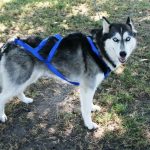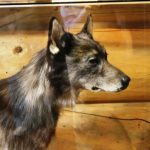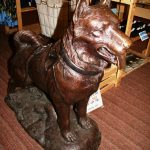- Morgan modeling a newer harness.
- Togo, Seppala’s lead dog who led the most miles in the 1925 run to deliver diphtheria antitoxin to Nome.
- Balto statue at Iditarod Headquarters, Wasilla, Alaska
- Leather replica of Balto’s harness. My left hand holds the padded section that goes around the neck.
When I introduce the Iditarod Trail Sled Dog Race™ to my students, I use an article, The Story of the Iditarod Trail, for them to read. I watch them reading it to themselves or to their partners, and, it never fails, they perk up and recognition glows on their faces when they read about Balto in that article. They say, “I know Balto!” because they’ve read a book or seen a movie about him.
Togo and Balto were the lead dogs on Leonhard Seppala’s and Gunnar Kaasen’s teams which helped deliver antitoxin to Nome in 1925 to stem a diphtheria epidemic. Both dogs were Siberian huskies, a breed brought to Alaska from Siberia by William Goosak, a Russian fur trader. These dogs were smaller and leaner than the huge dogs being used at that time to pull freight sleds delivering mail, supplies, and bringing out gold in Alaska. Their nickname was not very complimentary—“Siberian Rats”. The Siberian husky breed was officially recognized in 1930 by the American Kennel Club, and many sled dogs today descend from Seppala dogs.
Roald Amundsen planned to use Togo and his teammates for a North Pole expedition which was cancelled. Seppala continued to train and race the dogs, and in 1925, was called upon to run a long leg of the route to deliver the diphtheria antitoxin. Togo led the team the longest distance, 260 miles, while other teams ran distances of 25-40 miles.
Balto, another Siberian husky owned by Gunnar Kaasen, led the last team to carry the medicine into Nome. Whiteout blizzard conditions and snowblindness forced Kaasen to rely heavily on the 3 year old dog’s abilities. (Source: http://www.shca.org/shcahp2d.htm 9.11.10).
Read more about Togo and Balto at these sites.
After his death, Togo was preserved by a taxidermist and is on display at the Iditarod Headquarters in Wasilla, Alaska. In December 1925, a statue of Balto was unveiled in New York’s Central Park. Determined that Balto would also be on display in Alaska, Kim Raymond searched, located, and arranged shipping of a second Balto statue to the Iditarod Headquarters in 2009. Togo’s statue stands in New York City also, at Seward Park.
These photos are of Togo, Balto, and a replica of the leather harness that Balto wore. I am holding it at Jon and Jona VanZyle’s house in Alaska. Jona worked at the Cleveland Museum in Ohio at one time. The museum owns Balto who was preserved by a taxidermist after his death. Jona found the harness in a collection of items the museum holds from the time when Balto and other team dogs lived at that museum. She had a replica made of the harness which is surprisingly heavy. It fits around the dog’s neck and behind the front legs, encircling the torso. Today’s sled dog harnesses are very lightweight and made of webbing which fits along the dog’s back and sides.
My dog, Morgan, is modeling a more modern type of harness. It is a little big for her, but she shows how a harness fits. By the way, a lot of people ask me if she pulls a sled. The answer is “No”. I rescued her about three years ago from our animal shelter, and while I’ve taught her gee, haw, straight ahead, and on by commands, we just go for FAST walks! (say jee, it means right; haw means left)
Mushing on,
Martha






